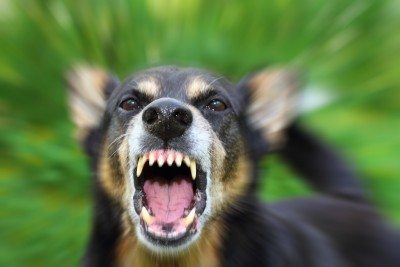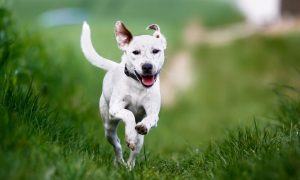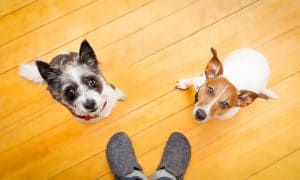“This post contains affiliate links, and I will be compensated if you make a purchase after clicking on my links.”
Hey everyone,

We have been getting a ton of questions on how to fix aggression in a dog toward other dogs. Instead of answering the questions individually I figured I would just write a piece on how to do it.
Dog aggression, or dog aggressiveness issues as I more commonly refer to it, is not an uncommon problem. This is something that can be very frustrating for an owner to deal with. Your first goal when dealing with this issue is to do your best to prevent your dog from biting or attempting to bite again. It is extremely important that your dog stops rehearsing the unwanted behavior. Keeping a safe distance between your dog and others is going to be very important. If your dog has certain dogs that it likes and gets along with, use those dogs to your advantage. Part of this rehabilitation process is teaching your dog how to interact properly with other dogs. That’s why if your dog does have some friends then its important he gets to play with them properly. Make sure to always supervise these play sessions.
Lets talk about Counter Conditioning. If you have a dog that is nervous around other dogs, or dislikes other dogs, this is going to be the best way to fix it. Counter Conditioning is a gradual process that will actually change the underlying emotion that your dog has about in this case, other dogs. The goal with this Counter Conditioning is to show your dog that when other dogs are around only good things happen. This is a scientific process proven to work.
The goal with Counter Conditioning is to start off at a very safe distance where your dog can see other dog(s) but doesn’t necessarily feel the need to react. Every time he looks at the dog reward him. If he does NOT react tell him “good boy” and reward him. If he does react toss him a treat but do NOT say “good boy.” If he does react and you give him a treat you are NOT rewarding his behavior. This is the big misconception. What we are doing is telling him every time he looks at another dog, good things happen. When things are going smoothly at that distance move closer to the other dog. This is something you need to take your time with. If you try to move too quickly you will only set your dog up to fail.
Lets talk about a couple different ways to set your dog up for failure. One of the biggest mistakes people make is trying to use a prong, choke, or shock collar. The idea behind using one of these is to punish the dog for giving a reaction toward another dog. One thing I’ve seen first hand many times is a dog goes toward another dog in a curious way, and the owner doesn’t like it and gives a collar correction. Well the owner thinks that the dog won’t do it anymore because the dog was punished, but what the owner is really doing is giving its dog a negative association every time it is around another dog. Basically the dog starts to associate seeing other dogs with pain, which more often than not causes the dog to be reactive around other dogs. So not only will using one of these not fix a dog with aggressiveness issues, it can and most likely will make it worse. The other thing is, if it does work in the way that it is intended, it’s only going to work when the owner is around. When the owner isn’t around the dog is very likely to be reactive again. This is because by using punishment you are not actually changing the way that the dog feels about other dogs, you are just making it not react because its afraid of the punishment that follows from the owner.
In conclusion, how quickly this will work is dependent upon a couple things. One thing is how severe the issue is to start with. If your dog is a bit older and has been rehearsing this for years, it’s going to take longer to fix. If this is a fairly new problem, in theory it won’t take as long to fix. The other thing is how much work/repetition the dog gets. If this is only worked on once a month you won’t really see results. This really needs to be worked on daily/ every other day.
Thanks for reading!
Kevin Duggan CPDT-KA
Kevin is a Certified Professional Dog Trainer through the Certification Council for Professional Dog Trainers (CCPDT.org) and is a Canine Good Citizen Evaluator through the American Kennel Club. He currently resides in Ohio with his dog, V, a six-year-old Shepherd/Lab mix, where he operates All Dogs Go To Kevin, LLC, specializing in helping build positive relationships between humans and their canine companions using clear communication, not pain and fear. For more training tips and tricks, and to meet his amazing dog, V, follow him on Facebook by clicking here.



















jenny charles
Jan 2, 2014 at 1:12 pm
My 5 year old black lab began attacking all other dogs about 3 year ago, I have a 9 year old small breed. A 3 year old Dalmatian and Bentley and the lab runs the showman can not allow any other dogs to come around, or there will most likely be a dog fight, Bentley has attacked the Dalmatian several times, he warns him with a growl and then if Oreo continues to irritate him then we are breaking a dirty dog fight, I hate it, cause I love them both, is this a pack leader issue? Cause the small dog use to bite and boss the lab but the lab tossed him across the room last year and now the little one is scared of him too.
Paula Brooks
Jan 2, 2014 at 12:05 pm
What if my dog is not a treat taker?
carla brown
Jan 2, 2014 at 12:12 pm
Try a toy – the squeakier the better. It worked with my JRT
Gerrie
Sep 13, 2013 at 12:41 pm
I have a different problem. I have a 4 year old spayed female Great Pyrenees that was raised with 5 other dogs and started tagging them when she was 3. It happens very infrequently. She will be relaxed and calm and another dog will walk by and she will roar and bite them. Luckily she did not do any damage but it is frightening. I have been keeping her separate from them. It seems like she is being territorial over a space, but it is not the same space it is just whatever spot she decides she owns that day.
Beth
Sep 14, 2013 at 12:09 pm
Gerry, I would get your dog checked out by a vet to ensure she isn’t in pain. Grumpiness (fortunately, it has never grown to a bite with mine) towards my other dogs is always one of the first signs in my dogs that something isn’t right/ that they are hurting. Beth
Rachel Morrison
Sep 16, 2013 at 10:23 am
Hi Gerrie, I am having the same issue with my dog. She has a “1 on 1” training this week and I will relay the information I receive. Hopefully, it is helpful to both of us.
Rachel Morrison
Allan Douglas
Sep 13, 2013 at 11:36 am
I have a foster dog who is a lamb with people. And gets along fine with my two dogs when it’s just them. But if my wife or I are in the mix, the foster gets VERY aggressive toward my dogs.
How do I deal with this apparent jealousy issue?
Kevin Duggan CPDT-KA
Sep 26, 2013 at 12:28 pm
It sounds like it may be a guarding issue. I would do a lot of praise when all are around and he makes a good decision. If he makes a incorrect decision there are a couple things you can do. If in fact he is guarding one of you, if he starts, just get up and walk away. By doing this you will be removing what he is guarding, which will then give him no reason to guard. If he tries to follow through safely remove him from everyone for a period of time. When everything has calmed down you can try again. Remember to praise him for making the correct decision… A lot.
darlen
Sep 13, 2013 at 10:15 am
How does the dog know the difference he gets a treat either way? My dog gends to whine when he sees another dog he has always done this he is now 11 years old and lives with 3 other dogs i dont get it but love him just the same thanks
Kevin Duggan CPDT-KA
Sep 26, 2013 at 12:25 pm
Overall we do want the dog to get a treat either way, and realize that he gets it either way. With repetition he will start to associate the other dog with good things and have no reason to react.
darlen
Sep 13, 2013 at 10:12 am
How is the dog not connecting the difference he gets a treat either way?